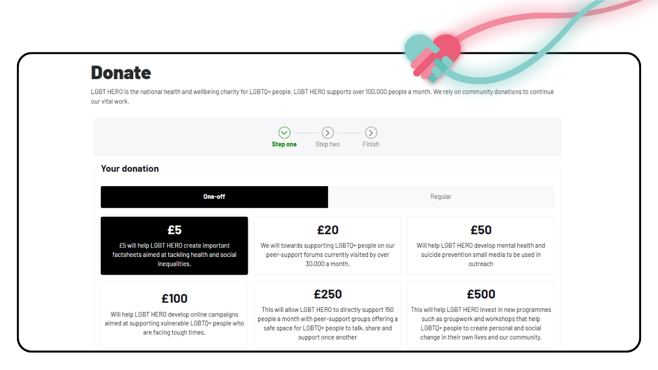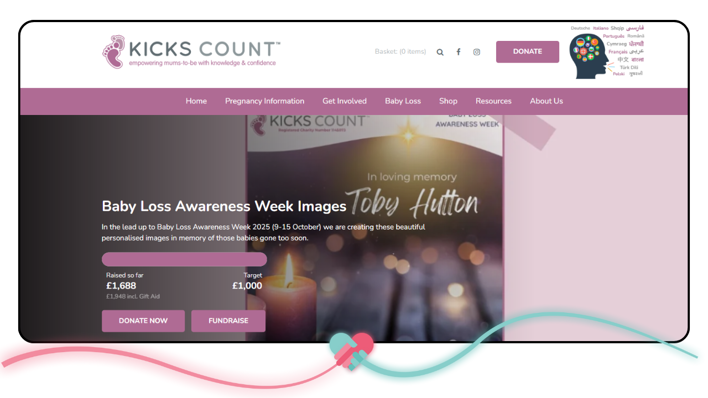
What is digital fundraising?
When people ask "what is digital fundraising" the simplest answer is: raising money online. But in practice, it’s far more creative.
It includes everything from social media appeals and crowdfunding pages to QR codes, virtual events, online giving - and everything in between.
At its heart, digital fundraising helps charities meet donors where they already are, be that on their phones, inboxes, or their favourite social platforms.
Top digital fundraising ideas and tips
Successful digital fundraising starts with connection - not just campaigns. Before diving into your next big idea, it’s worth taking a step back to make sure your digital setup makes it easy for people to support you. The best fundraising ideas build relationships as well as revenue.
Below, you’ll find our favourite digital fundraising best practices - a practical starting point to help you strengthen your foundation and grow your online giving.
1. Build strong foundations
Before you launch your next digital fundraising idea, make sure your basics are solid. That means a reliable, user-friendly donation platform that’s easy to navigate, mobile-optimised and fast.
Keep forms short, allow recurring donations, and make the process smooth, because every extra click risks losing a donor.
Quick checklist:
- Clean design and clear calls to action
- Mobile-friendly layout
- Few required fields
- Multiple payment options (card, PayPal, Apple Pay, Google Pay)
- Option to give monthly
2. Keep the donation journey friction free
We’ve all abandoned a clunky checkout before, and donation pages are no different. Aim for simplicity, not flashiness. Use plain language, balanced visuals, and only as many options as donors truly need.
Less friction = more giving.
We love this example from LGBT Hero, who use their Access Raise website and fundraising platform brilliantly. They've kept their donation page simple, uncluttered and clear about how every gift will be used - a perfect model of transparency and trust.

3. Offer choice without overload
Give donors several trusted payment options, but don’t clutter the page. A small variety builds trust and makes it easier for people to donate the way they prefer.
Many donors now use digital wallets or PayPal for one-off donations. Make sure you're catering to modern habits!
4. Launch a targeted crowdfunding campaign
Crowdfunding is one of the best digital fundraising ideas of recent times, especially for specific, time-bound projects. It personalises the giving experience, allowing donors to see progress and impact through goal trackers and updates.
Crowdfunding also makes sharing simple. Your supporters can spread the word across social media in a mere click, multiplying reach beyond your existing network. Other benefits include:
- No application process
- Avoiding long waiting periods to receive funds
5. Bring your stories to life
Video is no longer a nice to have. Short-form storytelling is how people consume almost everything now - from TikTok to YouTube Shorts.
If you embrace this, show real people, real outcomes, and tangible change. A 30-second clip from a beneficiary or volunteer can be more powerful than a polished advert. According to HubSpot, the average person now spends over 17 hours a week watching online video, up sharply since 2022.
Let your donors see and feel the difference their support makes.
6. Use social media to build community
The most successful digital campaigns tap into a sense of belonging. Social platforms like Instagram, Facebook, and TikTok let you bring donors closer to your cause, with behind-the-scenes content, live updates, and easy sharing.
Think of your social channels not just as billboards, but as places for two-way conversations. Respond, thank, and celebrate supporters publicly - it inspires others to join in.
Here's more on the benefits of social media for charities.
7. Show social proof with donor walls
People are social creatures. We’re far more likely to give if we see others doing the same. Displaying donor names, totals, or messages creates trust and momentum.
You can also use testimonials or case studies to demonstrate real impact. For smaller charities in particular, these “trust signals” can make a huge difference.
A great example of this in action comes from Kicks Count, who fundraise using their Access Raise website. Their homepage features a clear totaliser showing progress towards their campaign target, and it’s immediately obvious they’ve smashed it. That visible success helps build excitement, trust and motivation for new donors to get involved.

8. Thank your donors
An immediate, heartfelt thank-you can turn a one-off gift into a lifelong relationship - and this is where your charity CRM really comes into its own.
Automate donation receipts so every supporter receives an instant acknowledgment, then use your CRM to segment donors and follow up with messages that feel genuinely personal. A quick “thank you” email can be automated, but a follow-up message that references a donor’s specific gift or campaign connection shows real care. The key is to make gratitude feel genuine, not generic.
Your CRM also keeps track of previous interactions and communication preferences, helping your team build long-term relationships rather than starting from scratch each time.
9. Measure, learn and refine
The smartest digital fundraising ideas are backed by data. Track visits, click-throughs and conversions help you to understand what’s working.
Analytics within your content management system are a great place to start. Tools like Google Analytics 4, Search Console, and Looker Studio help visualise your campaign performance and drill down even deeper. Make sure you look at:
- Total visits
- Bounce rates
- Click through rates (CTR)
- Conversion rates
- Session duration
Top tip: Test one variable at a time, such as your call-to-action text or imagery, to learn what really resonates.
Fresh digital fundraising ideas in action
Digital innovation keeps reshaping how charities engage donors. Here are a few standout examples:
Contactless donations
Quick, easy, and now commonplace. Contactless devices in public spaces make spontaneous generosity possible anywhere. Quick, convenient, and with GoodBox reporting ROI’s up to 1,384% this is one trend that’s here to stay.
- Example: Cambridge City Council
Cambridge City Council set up the ‘Street Aid Fund’ to fight against homelessness. They partnered with local Co-ops to install contactless donation points, making £3 gifts accessible to shoppers at any time.
Charity gaming and streaming
With the global gaming market exceeding $200 billion, charity gaming is one of the fastest-growing digital fundraising ideas. We love how charities across the UK are ‘game-raising’ their way to success.
- Example: Jingle Jam
Jingle Jam is the world’s biggest games charity event which first launched in 2011. It turns gameplay into global giving, raising over $25 million to date by engaging streamers and fans through donation-linked bundles.
QR codes
A machine-readable code created through a matrix of black and white squares, QR codes (aka quick response codes) are still going strong. QR codes connect the offline world to online donations in seconds.
- Example: Macmillan Cancer Support
Macmillan Cancer Support use QR codes in several ways, including in their ‘World’s Biggest Coffee Morning’ packs. These codes making it easy for hosts and guests to give directly via mobile.
Virtual reality
Virtual reality is a simulated 3D environment that allows participants to use their senses to explore and interact with a virtual surrounding that emulates reality. In short, it brings empathy to life.
- Example: WaterAid
WaterAid made effective use of VR with their ‘Aftershock’ charity campaign. VR film transported viewers to earthquake-hit Nepal to witness the power of clean-water infrastructure firsthand - a powerful emotional trigger for giving.
Find out more about charities bringing virtual reality to life.
Building a sustainable digital fundraising strategy
Digital fundraising isn’t a one-off project, it’s a continuous process of learning, adapting and improving. Here’s how to make your digital fundraising ideas sustainable:
1. Build on what works
Reflect on your past campaigns, analyse the data, and double down on proven tactics. Small, steady improvements compound into big results.
2. Focus your efforts
With so many opportunities out there, it can be tempting to try and do it all. This can be counterproductive though, especially if you’ve got a small team and limited resources. You don’t need to chase every shiny new tool. Choose digital fundraising ideas that align with your capacity and audience.
Moral of the story: play to your strengths.
3. Remember to create great content
You can have the best technology in the world, but if your content is underwhelming, the message will fall flat. Ideas are everywhere. User-generated stories from service users, volunteers, or beneficiaries are almost 10 times more impactful than influencer content. That’s great news for charities, who have no shortage of service users, supporters and staff to inspire great fundraising campaign ideas.
Relevant: If you want the reach, you need to tap into local, national and international news. Keep an eye out for the stories that work for you.
4. Invest in people, not just platform
Don’t get so distracted by the wonders of digital that you forget to invest in the people that deliver it. Digital success depends on your team’s skills and confidence. Invest in upskilling and ongoing training, be that through webinars, peer networks, or professional development courses, will always pay you back in the end.
5. Research sector trends
No charity is an island, and it's important to understand the trends that shape the sector. From what we're seeing, expect continued growth in:
- AI-powered donor insights and personalisation
- Hybrid online/offline events
- Subscription-style giving models
- Short-form video and social commerce
6. Stay curious
Digital fundraising is never done, so make experimentation part of your culture. Test new digital fundraising ideas, pilot small projects, and celebrate learning as much as success.
The bottom line
Digital fundraising offers almost limitless opportunities for creativity and connection. Whether through crowdfunding, contactless payments, gaming or heartfelt storytelling, the goal remains the same: to inspire generosity and make giving easy.
Start with one or two digital fundraising ideas, build on your data, and keep learning. The digital world moves fast, but with the right approach - and the right tools like Access Raise - your fundraising can move even faster.
Further reading:
The complete guide to charity website development
What makes a good charity website?
REFERENCES
GoodBox: Contactless technology: Worth the investment?
Jingle Jam: Jingle Jam - The official website

 AU & NZ
AU & NZ
 SG
SG
 MY
MY
 US
US
 IE
IE
